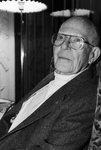
Raymond Davis Jr. shared one of the 2002 physics prizes with Masatoshi Koshiba of Japan for the detection of cosmic neutrinos. The other prize went to Riccardo Giacconi (Italy/USA) for his work on cosmic X-rays. The neutrino particle was predicted by Wolfgang Pauli as early as 1930, but it was only confirmed 25 years later by Frederick Reines. This is because neutrinos hardly interact with matter and so are very difficult to detect. Billions of neutrinos pass through us unnoticed every second. Raymond Davis set out, as the song says, to catch a falling star. Over a period of 30 years he succeeded in capturing a total of 2,000 neutrinos from the Sun in a gigantic tank filled with 600 tonnes of fluid, placed in a mine, thus proving that hydrogen-helium fusion – the source of neutrinos – powered the Sun.
Raymond Davis was born in Washington, DC in 1914, the son of a photographer and inventor who provided Raymond with chemicals for experiments in his own basement laboratory. Little wonder, then that he gained a degree in chemistry at the University of Maryland in 1938. After working for Dow Chemicals in Michigan for a year, he returned to Maryland for his MSc, before going on to Yale and gaining a PhD in physical chemistry in 1942. During the war he performed chemical weapons tests in Utah and in 1945, went to work at the Monsanto Chemical Company in Miamisburg, Ohio, doing applied radiochemistry for the Atomic Energy Commission.
In 1948, he joined the new Brookhaven National Laboratory, where he enjoyed “a long career of doing just what I wanted to do and getting paid for it”. Reading a paper by HR Crane inspired him to attempt an experiment in neutrino physics, although early attempts ended in failure. He also had the task of screening rock and ‘air’ samples from the Moon, and at one time ended up in quarantine when one of the sample boxes leaked.
In the early 1970s, Davis decided to detect neutrinos from the Sun, building a 100,000–gallon tank filled with perchloroethylene, a solvent used for dry cleaning, a mile down in the Homestake Gold Mine in South Dakota. Eventually they produced a solar neutrino signal, but approximately only one-third of the expected flux from that calculated by John Bahcall. Scientists bickered for years over the discrepancy until observations at the Sudbury Neutrino Observatory in Canada showed both parties were right, but two thirds of neutrinos change into other flavors en route to the Earth and were not detected.
Davis retired from Brookhaven in 1984, moving the Homestake administration to the University of Pennsylvania where he continued to catch the odd neutrino until the late 1990s. Davis met his wife Anna Torrey at Brookhaven and had five children, two of whom followed their parents’ footsteps. He died in May, 2006.
This text of the Nobel Laureate was taken from the book: "NOBELS. Nobel Laureates photographed by Peter Badge" (WILEY-VCH, 2008).
